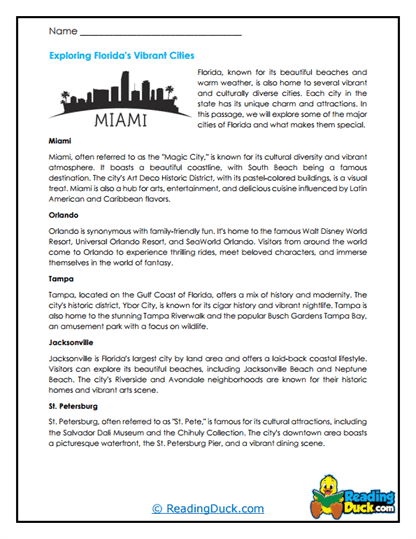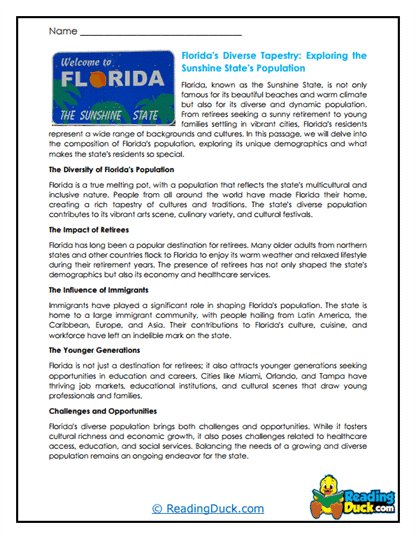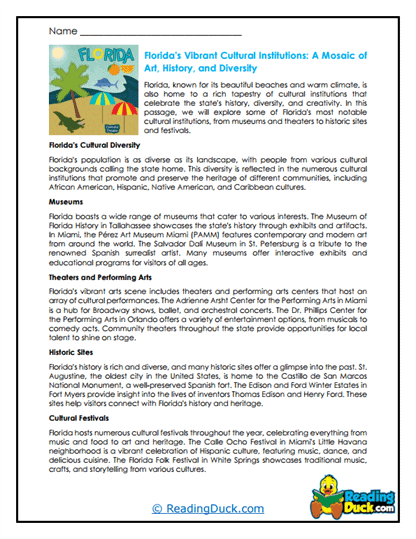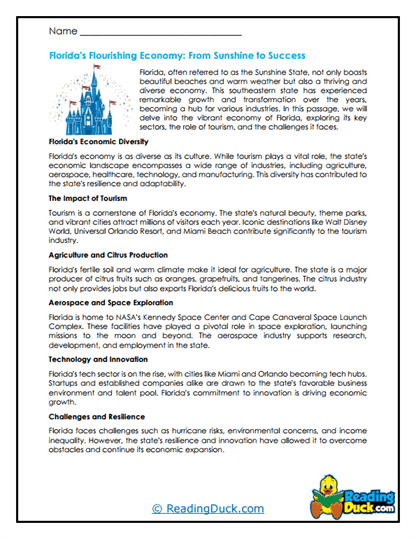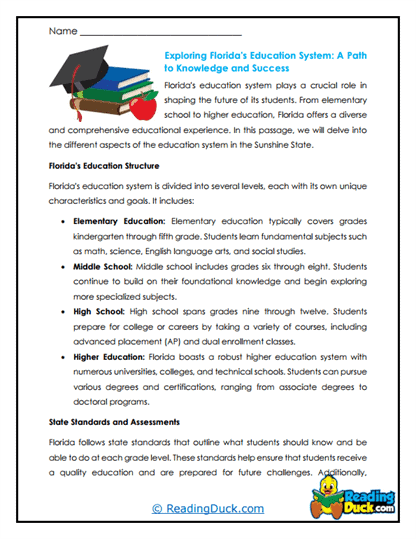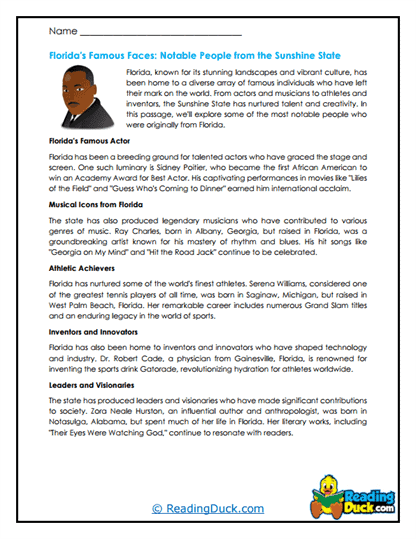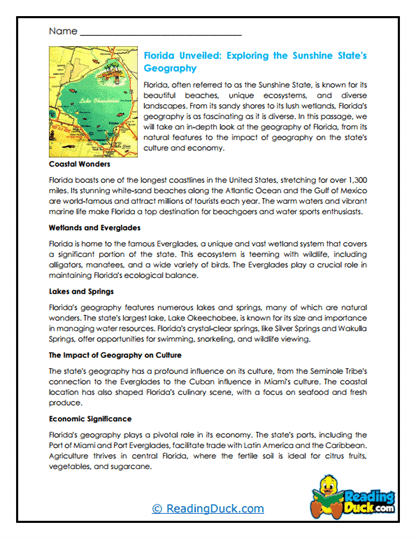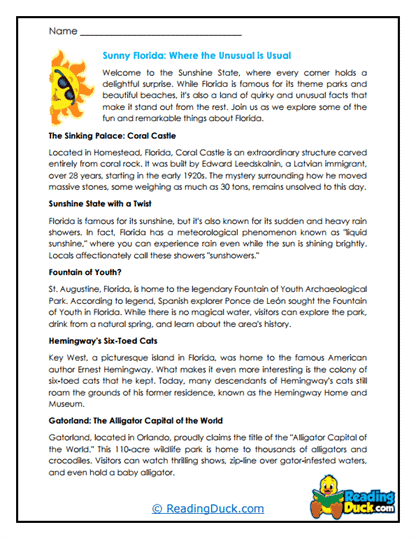Florida Worksheets
About Our Florida Worksheets
Our collection of Florida worksheets offers a comprehensive and engaging way for students to explore the rich history, diverse geography, and unique culture of the Sunshine State. As part of the Social Studies curriculum under U.S. History, these worksheets help students understand the important events, landmarks, and cultural influences that have shaped Florida. Each worksheet set is designed to reinforce key concepts and encourage critical thinking through various question formats and visually appealing content.
Each worksheet set includes:
- Multiple Choice Questions: These questions assess students' understanding of the reading passage by offering several answer options, helping to reinforce essential facts and concepts about Florida’s history, geography, and culture.
- Short Answer Questions: In this section, students are encouraged to write their own answers to questions based on the reading passage. This format allows students to express their understanding in their own words, promoting deeper comprehension of the material.
- Open-Ended Questions: These questions prompt students to provide personal input, opinions, or reflections related to the reading material. This format encourages students to connect the topic of Florida to their own experiences and broader understanding of U.S. history and geography.
An answer key is provided for all question sheets, making it easy for teachers and parents to review and assess students' work. All worksheets are available as PDF files, which can be easily viewed electronically, downloaded, and printed for use in classrooms or homeschool settings.
Exploring Florida: A Journey Through Its History and Culture
Florida is a state with a fascinating and varied history that stretches back centuries, making it a rich subject for study in U.S. history classes. When introducing students to Florida, it’s important to cover the key events and cultural developments that have shaped the state from its early days to the present.
Early History and Indigenous Peoples
- Native American Tribes
- Diverse Cultures: Long before European explorers arrived, Florida was inhabited by various Native American tribes, including the Seminole, Timucua, and Calusa. These tribes developed complex societies, with rich traditions, social structures, and economies that were deeply connected to the natural environment.
- Adaptation to the Environment: These indigenous groups adapted to Florida’s unique environment, using its resources for fishing, hunting, and agriculture. They built impressive structures, such as mounds and villages, and maintained trade networks that extended across the region.
- European Exploration and Colonization
- Spanish Influence: Florida’s European history began with the arrival of Spanish explorers in the early 16th century. Juan Ponce de León is famously credited with being the first European to explore Florida, and he named the land “La Florida,” meaning “land of flowers.” The Spanish established St. Augustine in 1565, which is the oldest continuously inhabited European-established settlement in the continental United States.
- Colonial Struggles: Florida’s colonial history is marked by periods of Spanish, French, British, and finally American control. Each of these powers left a distinct mark on Florida’s culture, architecture, and demographics. The state changed hands multiple times before becoming a U.S. territory in 1821.
Florida’s Road to Statehood
- Territorial Period and Statehood
- Growth and Development: As a U.S. territory, Florida saw significant growth in population and infrastructure. The construction of forts, roads, and settlements helped expand the territory, although this growth often came at the expense of Native American populations, leading to conflicts like the Seminole Wars.
- Statehood: Florida was admitted as the 27th state of the United States on March 3, 1845. Its admission came during a time of national expansion, as settlers continued to move into the state, attracted by its warm climate and agricultural potential. The state's economy was largely based on agriculture, particularly cotton, sugar, and citrus fruits.
- Civil War and Reconstruction
- Confederate State: During the Civil War, Florida seceded from the Union and joined the Confederacy. Although it was one of the least populous states at the time, Florida played a key role in supplying the Confederate forces with goods and materials. The war and its aftermath significantly impacted the state's economy and society.
- Reconstruction: After the Civil War, Florida underwent Reconstruction, a challenging period marked by efforts to rebuild the state’s economy and integrate formerly enslaved people into society. This era saw the rise of new political and social dynamics, laying the groundwork for future civil rights movements.
Modern Florida
- Economic Growth and Tourism
- Tourism Boom: Florida’s economy transformed dramatically in the 20th century, driven largely by the growth of the tourism industry. The development of theme parks, such as Walt Disney World in Orlando, and the state’s beautiful beaches have made Florida one of the top tourist destinations in the world. The tourism industry continues to be a major economic driver, contributing billions of dollars to the state’s economy annually.
- Space Exploration: Florida also became a key player in space exploration with the establishment of the Kennedy Space Center on Merritt Island. This site has been the launchpad for numerous historic space missions, including the Apollo moon landings and Space Shuttle launches. The space industry remains an important part of Florida's economy and identity.
- Cultural Diversity and Influence
- A Melting Pot: Florida’s population is incredibly diverse, with significant influences from Latin America, the Caribbean, and Europe. This diversity is reflected in the state’s cuisine, festivals, music, and languages, making Florida a vibrant cultural mosaic. Cities like Miami have become cultural hubs that influence art, fashion, and music both nationally and internationally.
- Environmental Stewardship: Florida is home to unique ecosystems, such as the Everglades, a vast subtropical wetland that is a UNESCO World Heritage Site. The state has made significant efforts in recent years to protect its natural environment, balancing development with conservation. Florida's environmental policies and challenges, such as those related to hurricanes and rising sea levels, continue to shape its future.
How Florida Stands Out From Other States
Florida is unique in many ways, and its characteristics set it apart from other states in the U.S. One of the most distinctive aspects of Florida is its geographical diversity and climate. The state is a peninsula surrounded by the Atlantic Ocean and the Gulf of Mexico, giving it an extensive coastline that stretches over 1,300 miles. Florida’s warm, tropical climate makes it a year-round destination for tourists and residents alike. The state’s geography includes everything from sandy beaches and coral reefs to wetlands and forests, providing a wide range of habitats for diverse wildlife.
Another unique characteristic of Florida is its role as a cultural and economic gateway to Latin America and the Caribbean. Due to its proximity and historical connections, Florida has become a hub for international trade, finance, and cultural exchange. Cities like Miami serve as major centers for business and commerce, linking the U.S. with markets in Latin America. Additionally, Florida’s large Hispanic and Caribbean populations have significantly influenced the state’s culture, making it one of the most culturally diverse states in the nation. This blend of geographical beauty, economic significance, and cultural richness makes Florida a standout state in the U.S.
Using These Worksheets Creatively
Students can engage with these Florida worksheets in various creative ways that extend learning beyond the traditional classroom setting:
- Florida History Timeline - Have students create a timeline that highlights key events in Florida’s history, from its early Native American inhabitants to modern times. They can illustrate each event with images, symbols, or short descriptions, helping them visualize the state’s historical progression and understand how past events shaped its current identity.
- Virtual Tour of Florida’s Landmarks - Encourage students to research and present a virtual tour of Florida’s diverse landmarks and attractions. They can focus on specific sites such as the Everglades, Kennedy Space Center, or the Castillo de San Marcos, creating a digital presentation that takes their classmates on a journey through the state’s most iconic locations. This project allows students to explore Florida’s geography and cultural heritage in an interactive and engaging way.
- Cultural Comparison Essay - Assign students to write an essay comparing Florida’s cultural diversity with another state or region. They can discuss the influences of different immigrant groups, the impact of historical events, and the role of Florida in shaping national culture. This activity encourages critical thinking and helps students appreciate the unique cultural landscape of Florida.
- Environmental Debate - Organize a classroom debate on Florida’s environmental challenges and policies. Students can research topics such as climate change, coastal erosion, or the protection of endangered species, and present arguments on how Florida should address these issues. This debate fosters research skills, teamwork, and a deeper understanding of the state’s environmental significance.
These creative approaches not only make learning about Florida more engaging but also help students develop a deeper appreciation for the state’s rich history, diverse culture, and significant impact on the nation and the world.
